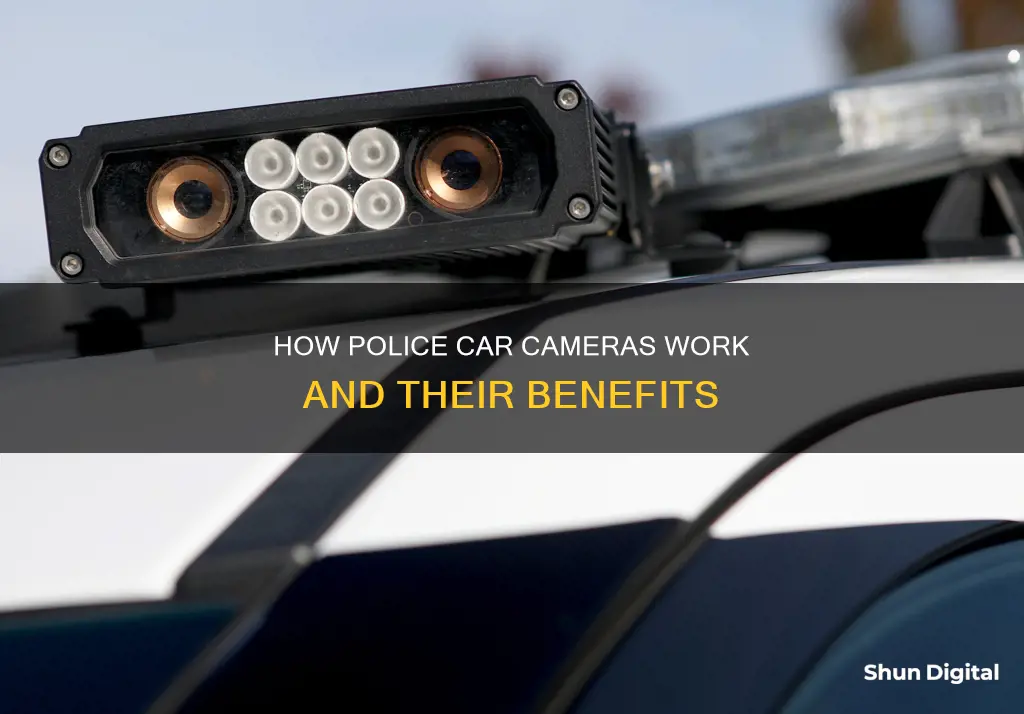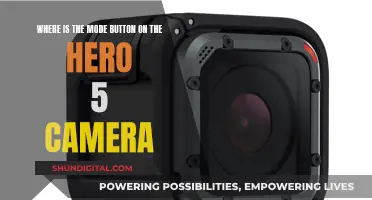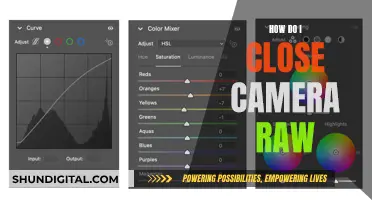
Police car cameras are an increasingly common feature of law enforcement, with 72% of state patrol vehicles now utilizing the technology. Mounted on the trunks or roofs of police cars, these cameras are used for automatic license plate reading, helping to enforce the law and stop criminals. They can also provide an objective record of what an officer encounters, increasing accountability and protecting both the public and the police.
| Characteristics | Values |
|---|---|
| Purpose | To provide an independent, objective record of what the officer encounters |
| Camera Position | One camera is positioned like a traditional dashboard camera, another faces out the back, two are mounted on the sides, and one keeps an eye on the back-seat prisoner |
| View | The cameras provide a 270-degree view around the vehicle |
| Audio | The officer wears a microphone that transmits audio back to the car |
| Recording | The cameras automatically record video when the car is turned on, and can capture up to 40 hours of video. Audio is activated when the officer pushes a button or when certain triggers are met, such as the emergency lights being turned on |
| Storage | The system has automatic wireless uploads to a secure encrypted server |
| Live Streaming | The system is capable of live streaming video to a command station |
| Additional Features | Some police car cameras are also used for automatic license plate reading systems |
What You'll Learn

Cameras can be triggered by events like emergency lights
The use of cameras in police cars has become increasingly common, with almost 72% of state patrol vehicles now utilizing this technology. These cameras are hardwired into the vehicle's electrical systems, allowing them to be activated by specific triggers. One such trigger is the activation of emergency lights and sirens, which can automatically prompt the camera system to start recording. This feature ensures that critical incidents and situations are captured on video, providing a detailed record of events.
The ability for cameras to be triggered by emergency lights is particularly advantageous for several reasons. Firstly, it ensures that officers do not have to manually activate the cameras during urgent or dangerous situations, allowing them to focus on their immediate tasks. Secondly, the automatic recording feature provides an objective and independent account of events, which can be crucial for evidence collection and court proceedings. This helps protect both the officers and the public by providing a clear and unbiased perspective of the incident.
In addition to emergency lights, police car cameras can also be triggered by other events or circumstances. For example, some cameras are set to automatically start recording when the vehicle exceeds a certain speed, such as 80 miles per hour. This can be useful for capturing high-speed chases or traffic violations. Additionally, cameras may be activated when the vehicle is involved in an accident, providing valuable footage for investigation and insurance purposes.
The integration of cameras with other systems further enhances their capabilities. For instance, some cameras can be triggered simultaneously with body-worn cameras within a certain range, providing a more comprehensive view of an incident. This coordination between in-car and body-worn cameras ensures that events are captured from multiple angles, increasing transparency and accountability.
The automatic triggering of police car cameras based on specific events, such as the activation of emergency lights, is a significant advancement in law enforcement technology. It not only improves the efficiency of evidence collection but also enhances the safety and trust between officers and the communities they serve. By capturing critical incidents and providing an objective perspective, these camera systems play a vital role in modern policing, contributing to a more effective and accountable law enforcement process.
Hot Springs Spas: Are Surveillance Cameras Watching?
You may want to see also

They provide a panoramic view of the car's surroundings
Police cars are now commonly equipped with cameras, which are typically mounted on the trunks or roofs of the vehicles. These cameras are designed to provide a panoramic view of the car's surroundings, offering a broad perspective of the activity around the police car. This multi-camera video system can offer a 270-degree view, enhancing the situational awareness of law enforcement officers.
The camera system typically includes five separate cameras that capture high-definition video and high-fidelity audio. One camera is positioned at the front, similar to a traditional dashboard camera, while another is directed towards the rear. Two cameras are strategically placed on the sides, often integrated into the light bar, to capture footage from the left and right of the vehicle. The final camera is focused on the back seat, monitoring any prisoners or detainees.
The panoramic view provided by these cameras is invaluable for several reasons. Firstly, it ensures a comprehensive record of the officer's encounters, providing an objective perspective that can be used as evidence in court proceedings. This helps in maintaining transparency and accountability, protecting both the officers and the public. The cameras automatically record video as soon as the car is turned on, capturing crucial footage that might otherwise be missed if manual activation were required.
Additionally, the panoramic view aids in officer safety during incidents. The live stream capability allows command stations to monitor situations in real time, providing valuable information that can inform tactical decisions and ensure the safety of the officers on the ground. The cameras also enhance the effectiveness of police work, as demonstrated in the example of a burglary investigation where footage from a side-view camera helped identify a suspect vehicle.
The integration of technology, such as panoramic camera systems, in police vehicles is a significant advancement that contributes to the safety and efficiency of law enforcement practices. By adopting these innovations, police departments can better serve and protect their communities while also improving the transparency and accountability of their operations.
Focusing Your Mirror Booth Camera: The Ultimate Guide
You may want to see also

Recordings are used as evidence and to increase accountability
The recordings from police car cameras are used as evidence in court. They provide an independent, objective record of what the officer encounters, protecting both the public and the police personnel. For instance, the recordings can be used to monitor officer activity and increase accountability, reducing the risk of impropriety from an officer. This also helps to protect officers against frivolous complaints.
In the case of the Palo Alto Police Department, the cameras have been used to investigate a burglary. A patrol car had passed by the burglarized business, and the video from the camera showed a suspect vehicle in the parking lot, aiding the investigation.
The recordings can also be used to review and improve officer training and performance. By analyzing the footage, law enforcement agencies can identify areas where additional training or resources may be needed. This proactive approach helps to enhance the skills and effectiveness of their officers, ensuring they are better equipped to handle similar situations in the future.
Additionally, the recordings can be used to promote transparency and build trust between law enforcement and the communities they serve. By releasing footage of critical incidents or providing updates on ongoing investigations, police departments can foster a more positive relationship with the public. This can lead to increased cooperation and collaboration, ultimately improving public safety and reducing crime.
The use of police car cameras has significantly impacted law enforcement, offering a range of benefits that extend beyond evidence collection. By increasing accountability, enhancing investigations, and building community trust, these recordings play a vital role in improving the effectiveness and transparency of policing.
Streaming Your Camera to Your Computer: The Finepix Way
You may want to see also

Cameras can be used for automatic license plate reading
Cameras on top of police cars can be used for automatic license plate reading. These are known as automated license plate readers (ALPRs). ALPRs are high-speed, computer-controlled camera systems that are typically mounted on street poles, streetlights, highway overpasses, mobile trailers, or attached to police squad cars. They can also be handheld or mounted on stationary poles.
ALPRs automatically capture all license plate numbers that come into view, along with the location, date, and time. This data, which includes photographs of the vehicle and sometimes its driver and passengers, is then uploaded to a central server. The data can be used by police to find out where a plate has been in the past, to identify travel patterns, and even to discover vehicles that may be associated with each other.
License plate recognition (LPR) cameras can be placed almost anywhere to capture detailed data about license plates and vehicles used to commit crimes, enabling quick and efficient action. LPR systems provide proactive, data-driven, actionable evidence for law enforcement investigations.
In the United States, less than 50% of violent crime gets solved, and police often lack the resources and evidence to pursue investigations. LPR cameras can help provide a clear direction for investigations and link vehicles to their history. This technology can also reduce the need for face-to-face confrontations and provide 24/7 protection.
Understanding Camera Raw Cache Files in Windows
You may want to see also

They can be set to turn on as soon as the car is started
The world of law enforcement has changed significantly in the last 20 years, with police car cameras becoming increasingly common. These cameras are hardwired into a vehicle's electrical system and can be set to turn on as soon as the car is started, ensuring that every incident inside and outside the car is recorded, regardless of whether the officer remembers to activate the camera manually. This is particularly important for collecting digital evidence and providing an objective account of events, which can be used in court proceedings and to increase accountability by monitoring officer activity.
The automatic recording feature of police car cameras offers several benefits to both law enforcement officers and the public. Firstly, it ensures that there is a comprehensive record of all interactions and incidents involving the police vehicle. This helps to protect officers against frivolous complaints and also safeguards the public against any potential impropriety by the officers. The recordings provide an independent and objective perspective, capturing not only video but also high-fidelity audio, which can be crucial in understanding the full context of an incident.
By having the cameras automatically turn on when the car is started, law enforcement agencies can ensure that the technology is used consistently and effectively. This eliminates the risk of human error or forgetfulness, ensuring that every moment is captured and recorded. The cameras provide a broad view of the activity surrounding the vehicle, with some systems offering a 270-degree panoramic view through multiple strategically placed cameras. This comprehensive coverage helps to capture important details that might otherwise be missed if the cameras were activated manually or had a more limited field of view.
Additionally, the automatic recording feature can aid in investigations and evidence gathering. For example, if a crime occurs near a police vehicle, the cameras may capture crucial footage or audio evidence, even if the officers are not actively involved in the situation at that exact moment. This demonstrates how the technology goes beyond simply recording interactions between officers and the public; it becomes a valuable tool for solving crimes and bringing perpetrators to justice.
The integration of police car cameras with the vehicle's electrical system also ensures that the cameras have a constant power source, eliminating the need for battery management and allowing for uninterrupted recording. This seamless operation further enhances the reliability and effectiveness of the camera systems, providing a continuous stream of data that can be wirelessly uploaded to a secure server for storage and future reference. Overall, the ability to set the cameras to turn on automatically when the car is started contributes to the efficiency, transparency, and accountability of law enforcement operations.
Unlocking the Secrets of Free Camera Mode
You may want to see also
Frequently asked questions
The cameras on top of police cars are used for an automatic license plate reader (ALPR) system. These cameras snap pictures of license plates and check them against local, state, and federal databases. This helps to notify police officers of any registration issues or alerts attached to a vehicle.
The cameras are hardwired into a vehicle's electrical system and can be activated by triggers such as emergency lights and sirens. Some cameras are set to turn on as soon as the car is started, while others require manual activation by an officer.
Multiple cameras on a police car provide a panoramic view, offering a broader perspective of the activity surrounding the vehicle. This includes front-facing, rear-facing, and side-facing cameras, providing a 270-degree view.
Police car cameras provide an objective account of incidents, protecting both citizens and officers. They serve as automatic digital evidence collection, aiding in investigations and increasing accountability by monitoring officer activity. The cameras also help in stopping crimes by quickly locating vehicles associated with APBs or suspected in robberies or kidnappings.







